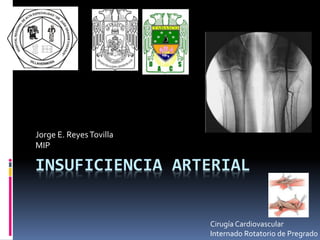
Insuficiencia arterial
- 1. INSUFICIENCIA ARTERIAL Jorge E. ReyesTovilla MIP Cirugía Cardiovascular Internado Rotatorio de Pregrado
- 3. Definición La insuficiencia arterial aguda y crónica es resultado de las alteraciones hemodinámicas producto e la obstrucción arterial brusca o paulatina en cualquier territorio e la economía.
- 4. Acute Limb Ischemia Is defined as sudden loss of limb perfusion and the term is applicable up to 2 weeks after an initiating event
- 5. Chronic Limb Ischemia Is reserved for patients with objectively proven arterial occlusive disease and symptoms lasting for more than 2 weeks.
- 6. Fisiopatología The lower extremity may be salvaged after up to 5 to 6 hours of profound ischemia. Skin and bone are relatively resistant to the effects of ischemia Nervous tissue is generally the most sensitive component of the extremity to the effects of ischemia Skeletal muscle plays a pivotal role in the numerous local and systemic manifestations of extremity ischemia-reperfusion injury. Alteración del flujo laminar se ocasiona turbulencia y como consecuencia lesión enotelial.
- 7. Síndrome de reperfusión Daño a la membrana celular Fallo de la bomba ATPasa Edema intersticial debido a permeabilidad de la membrana a iones proteínas y agua. Radicales libres que atacan a los ácidos grasos de la membrana fosfolipídica celular causando daño mecánico y funcional.
- 10. Cuadro clínico “Five Ps”: pain, pallor, paresthesias, paralysis, and pulselessness, to which some add a sixth "P"—poikilothermia or "perishing cold. Clinical evaluation is extremely important in determining the etiology and location of the obstruction. One of the most important pieces of information to obtain is whether the patient has had prior vascular procedures or if there is a history of LE claudication.
- 11. Exploración física Hipotermia Llenado capilar prolongado o ausente Alteraciones sensoriales o motoras Cambios irreversibles en músculo o piel Patients with acute arterial embolism generally have normal palpable pulses above the occlusion with a complete absence below.The pulse immediately above the occlusion may be particularly prominent with a “water-hammer” quality that results from limited arterial outflow.
- 12. Cuadro clínico de la CLI Patients have such long-standing and severe ischemia that irreversible ischemic injury to the extremity (manifesting as rigor of the muscles or frank gangrenous changes to the foot) has occurred. Dolor en ciertos grupos musculares producto de la actividad que ceden al descanso. Clauicación incapacitante Dolor en reposo Úlceras isquémicas
- 13. Diagnóstico clínico The diagnosis of LE occlusive disease often is made based upon a focused history and physical examination, and confirmed by the imaging studies. A well-performed physical examination often reveals the site of lesions by detecting changes in pulses, temperature, and appearances.
- 14. Diagnóstico por laboratorio y gabinete No invasores: - cuantificación de presiones sistólicas segmentarias en reposo y con prueba de esfuerzo - Doppler y ultrasonofrafía duplex - morfología e la onda de volumen del pulso - La presión parcial de O2 transcutáneo Invasores : - arteriografía ordinaria o - la de sustracción digital
- 15. Tratamiento médico IV heparin bolus (5000-10,000 units) and begun on a continuous infusion at 1000 units/hour.
- 16. Tratamiento quirurgico (ALI) Amputación: patients have such long- standing and severe ischemia that irreversible ischemic injury to the extremity (manifesting as rigor of the muscles or frank gangrenous changes to the foot) has occurred. Trombectomía
- 17. Tratamientoquirúrgico (CLI) Puentes arteriales: aortofemorales, femorfemorales o axilofemorales Angioplastías intraluminales percutáneas
- 18. Bibliografía Townsend: SabistonTextbook of Surgery, 18th ed. Schwartz's Principles of Surgery, Ninth Edition. Patología estructural y funcional 7 ed Tratado de cirugía general, CMCG, 2 ed
